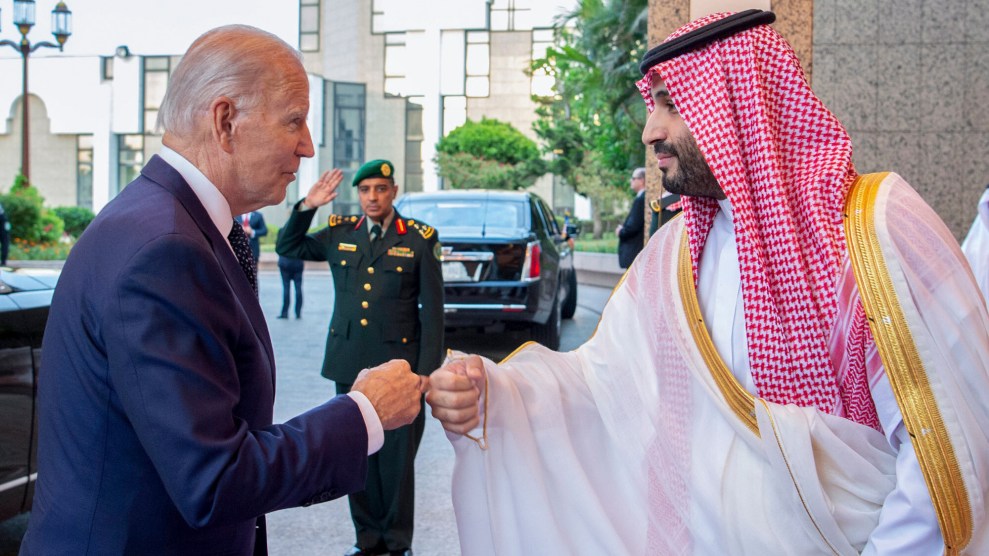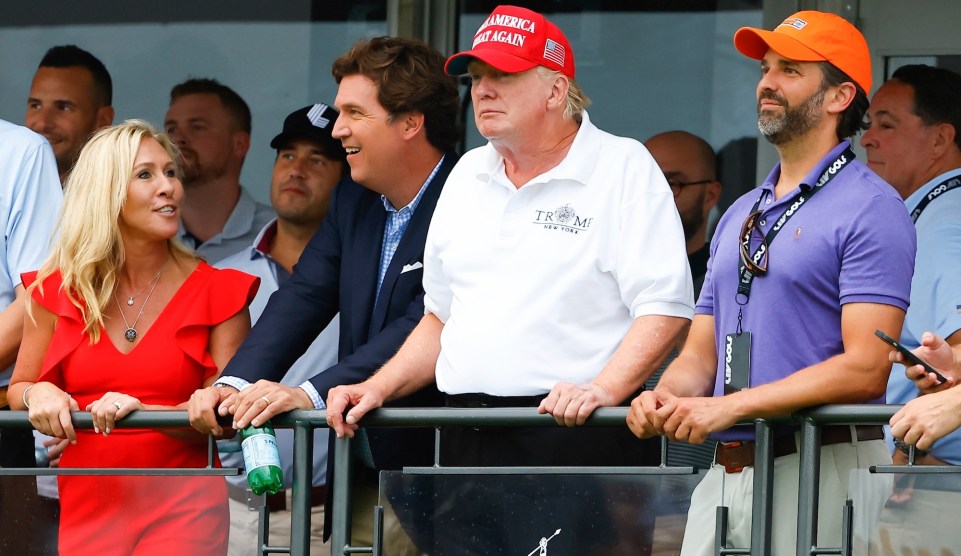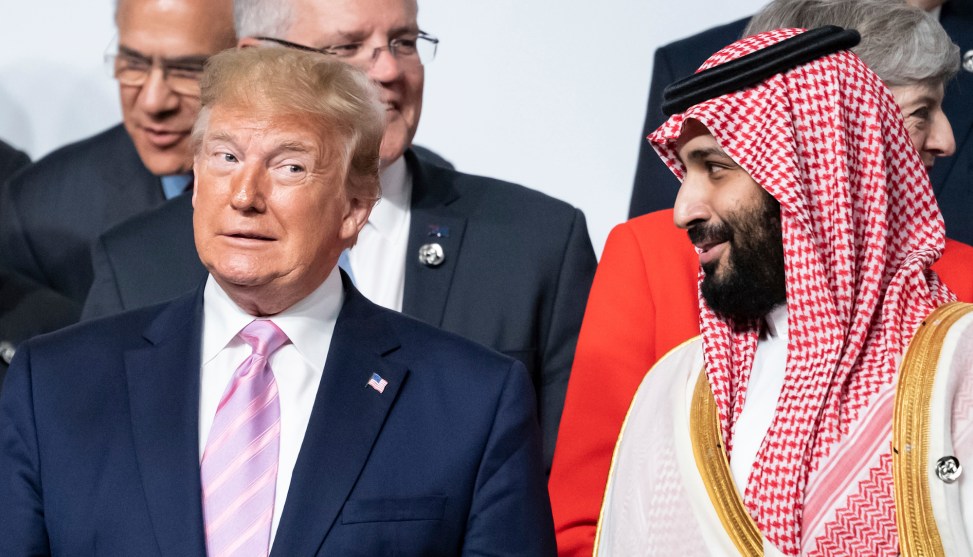Imagine a well-manicured golf course nestled in a valley formed by rolling green, tree-filled mountains. Men of a similar profile, but different ages, dot it: mostly white, often stocky, almost all wearing caps, polos, khaki shorts, and sunglasses—either Oakleys or Costa fishing specs—as they mill from hole to hole. There are women too; fewer of them, but in more varied outfits: dresses, polos, sleeveless polos, skirts, shorts, hats, no hats, blowouts, and so on. White, colonial-style homes that are too large to be called cottages (but are called cottages regardless) line the holes’ outer edges.
What you are imagining is the LIV Golf Tour’s tournament, held the first weekend of August on the Old White Course at West Virginia’s Greenbrier resort. And while that picture could easily describe most PGA Tour events, LIV is just a little bit different.

Bryson DeChambeau, Captain of LIV’s Crushers GC team, tees off.
Charles Laberge/LIV Golf/AP
The two organizations were briefly cutthroat competitors. But now, following the long standing PGA tour’s July merger with the upstart LIV, have become sister organizations. If you, justifiably, do not pay attention to golf—a very enjoyable but homogeneous, occasionally regressive, and sometimes indefensible sport—LIV is a Saudi Arabia-backed sports washing effort. After the kingdom’s initial forrays into sports like professional wrestling, it seems they decided to ratchet up the reputation laundering by attempting to buy out the opposite end of the cultural class spectrum.
I arrived on Friday afternoon, just missing the Navy SEAL parachuters who were brought in to land on the 18th green, a common highlight of LIV events. Around the entrance, LIV’s go-to neon green branding dominated; unlike on PGA Tour, there is no conglomeration of corporate sponsors. There is only LIV.
The tour’s motto—“Golf, But Louder”—was everywhere.
“What does that mean??” I muttered incredulously while passing a sign with the words emblazoned in all capital letters.

Matthew Wolff of LIV’s Smash GC team hits from the second tee.
Sam Greenwood/LIV Golf/AP
I quickly realized that it meant exactly what it said. There were some guys tasked with raising paddle signs colloquially commanding the crowd to “zip it” and “shhh.” But in marked contrast to the near absolute silence of the PGA Tour, conversations continued, only maybe slightly quieter. When people weren’t talking, speakers scattered by greens and tee boxes ensured that music—usually indistinct, poppy electronic dance music—was audible. The deeper I got into the course, there were fewer and fewer spectators. But the speakers and their EDM continued. It was like a bit that someone had committed to and refused to drop. The party would continue, people or not.
It was truly just golf, but with more noise. I cannot say they didn’t warn us.
The crowd was saner and less political than the one at a 2022 LIV event at Trump’s New Jersey golf club that Zach Helfand observed while writing for the New Yorker. Unlike him, I didn’t hear anyone refer to women as “hot bitches,” saw no one watching porn on their phone, and no one wearing a 9/11 memorial shirt while attending an event picketed by 9/11 families. On the West Virginia course, I spotted exactly one Trump hat and no other obvious political clothing. The weirdest thing I saw happen in public was a couple and a third-wheel friend loudly discussing the latter’s relatively recent divorce by the 9th tee box while we waited to see Brooks Kopeka. Compared to what went on at Bedminster, their conversation seemed much healthier and maybe even good for the divorcee, who did seem like he was working through demons.
I returned on Saturday, again just missing the Navy SEALs parachute. In a break from EDM, I’d already heard a track from The Silversun Pickups; this morning, as I walked towards a cooled viewing tent, I got hit with Spoon’s “Don’t You Evah.” LIV Golf was aware of the indie sleaze revival.
The tent’s full bar and DJ encouraged a festive mood. As Paul Casey, James Piot, and Charl Schwartzel putted on the 7th green just outside the tent, the DJ transitioned from Daft Punk’s “Get Lucky” to Earth, Wind & Fire’s “Let’s Groove.” I came to realize that I was not fully at a golf tournament, nor was I solely having fun—I was experiencing a simulation of both being at a golf tournament and having fun. (I’ve written about visiting a Capital One bank/cafe and feeling the same double simulation sensation.)
Yes, admittedly, I was having fun, but I was also being fed a series of enjoyable, pre-programmed inputs that signified fun: the music, the colorful signage insisting that we surrounded by a joyful, dynamic experience. There was a literal tournament being held, but no one seemed to care about the particulars. Matthew Wolff and David Puig led the pack for much of Saturday, but the crowds following their groups paled in comparison to the ones watching bigger stars, and no one looked to be keeping track of LIV’s team structure. The purpose of the tournament almost seemed to be so that LIV could say a tournament occured.
In my and LIV’s defense, America today often feels like wandering through a series of confusing hyperrealities that have been plucked from their original context, focus-grouped, sanitized, and optimized for some kind of efficiency (usually profit) before being placed back into public settings. Think of outdoor mall plazas that aspire to simultaneously be contemporary piazzas and updated versions of indoor malls—which were themselves already privatized simulacrums of town squares. I thought of trends in my home state of Texas, where subdivision development has evolved to embrace both a boatable, McMansion-filled Venice and a stone-wrought faux-Dalmatian “Adriatica Village.” I snapped out of it when the DJ put on an aggressive EDM remix of Nirvana’s “Smells Like Teen Spirit” and pondered what Kurt Cobain would think of his song being played here.

The winning Torque GC team celebrates.
Sam Greenwood/LIV Golf/AP
It is easy to poke fun at LIV, but the core of the product is undeniably good. Assembling some of the best golfers in the world and letting them ply their trade will inevitably produce spectacular moments. I watched Phil Mickelson hover over his ball, seemingly perplexed, before switching clubs and dropping an approach shot 5 to 10 feet from the hole. Bubba Watson then hit it even closer before it spun back slightly. On Sunday, Bryson DeChambeau completed the course with just 58 strokes, a low score that has only been achieved once in PGA history.
LIV’s goofy blemishes don’t matter and are kinks that can always be worked out. (Keep in mind that before eventually doubling down on events people took seriously, the X-Games featured absurdities like bungee jumping, snow shovel racing, and skysurfing—that’s skydiving with a board affixed to the jumper’s feet.) People around me recognized the quirks, but didn’t seem bothered—they just wanted to watch good golf.
But what probably can’t be worked out is the unsavory baggage brought by LIV’s state-affiliated backers. There was no Saudi branding, and aside from myself, no one of visible Middle Eastern descent. Accordingly, no one seemed interested in talking about the Saudi elephant in the room. They oohed and aahed when Dustin Johnson hit his drives, because Dustin Johnson hits the ball very far. They cheered when Mickelson landed close chips, his specialty.
But as I watched Watson and Mickelson go back to back on dueling approach shots, I noticed a drone hovering above. It was hard to not think about the other things Saudi Arabia does with drones, chiefly in Yemen, where its intervention in a civil war there has produced what the UN has called the “world’s worst man‑made humanitarian crisis.” But in the wake of LIV’s merger with the PGA, this is just the specter under which top-tier professional golf now happens.
The LIV tour’s events double as concerts. As the Zach Brown Band played later that night, I noticed a Customs and Border Protection sticker on one of Brown’s guitars, a reminder that the Kingdom does not have a monopoly on human rights abuses.
While I was in the viewing tent, I sipped on a cold shandy and looked out at the 7th green. A golfer’s high tee shot was sailing towards the hole. It slapped the green, bounced, and then spun back a bit within a few yards of the flag. The people around me clapped and cheered. An EDM remix pulsed in the background. Affixed to the edge of the tent were devices blasting a jet of cool mist in a struggle against the humidity and 85 degree heat. They felt good. I was having fun. I turned around to look at the par four, 10th hole and noticed a drone over the fairway, its cameras trained down. I started thinking about Yemen again.
















